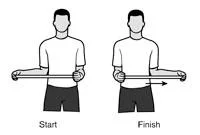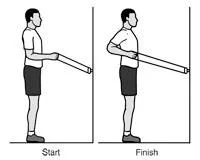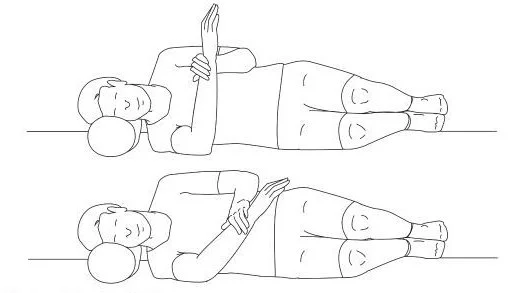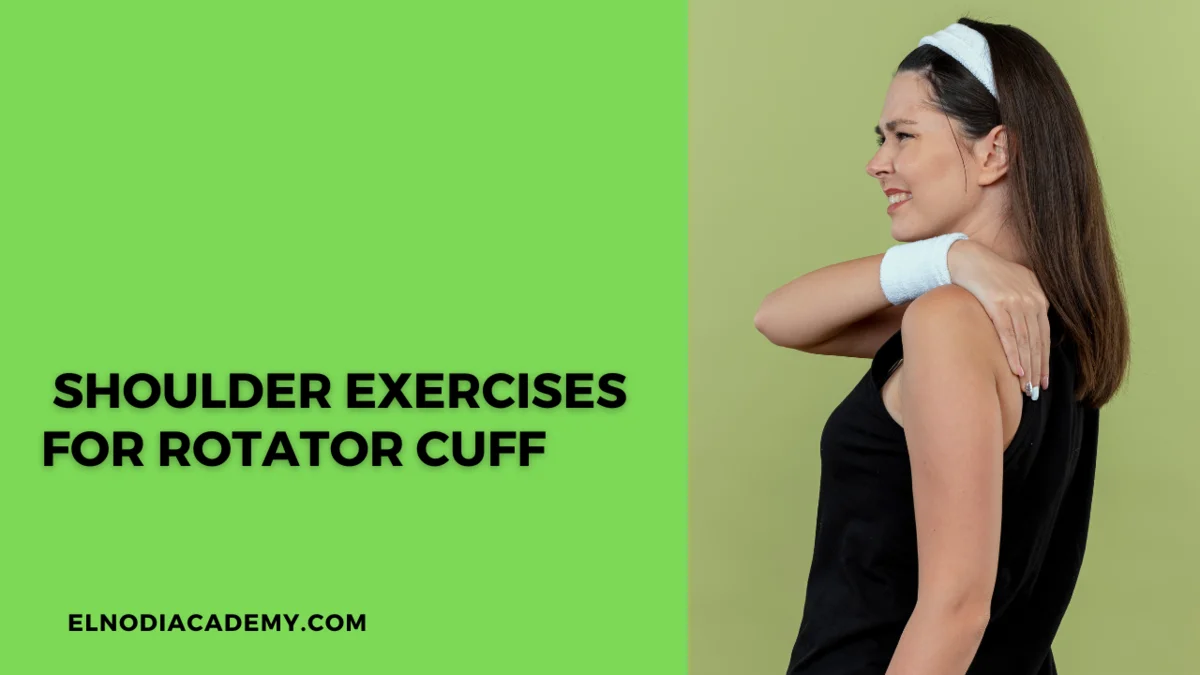Are you finding it difficult How to Properly Doing Shoulder Exercises for Rotator Cuff Damage? Check out our guide on how to do them.
The rotator cuff is one of four muscular groups. in the shoulder and they are responsible for several movement tasks including abduction (the arm moving forward), external rotation (turning the arm outwards), and Internet (inner) rotation. When these movements become compromised, it can lead to shoulder pain and other injuries.
Shoulder Exercises for Rotator Cuff
This is a broad conditioning program with a number of activities. To guarantee that the program is safe and successful for you, it should be carried out under the supervision of your doctor. Consult your doctor or physical therapist to determine which exercises will best help you achieve your recovery objectives.
Developing the connective tissues supporting the arm will help to keep your shoulder joint stable. Keeping them strong and healthy can help reduce painful shoulders and prevent additional damage.
Extending the muscle you are strengthening is critical for restoring the range of motion and avoiding injury. Gentle stretching after lifting weights will assist reduce muscle soreness and Hold your tendons long and flexible.
Muscle Groups addressed: The following muscle groups are addressed in this conditioning program:
- Front, back, and over-the-shoulder deltoids
- Trapezius (upper back) muscles
- Upper back rhomboid muscles
- Teres muscles (supporting the shoulder joint)
- Supraspinatus (shoulder joint support)
- Infraspinatus (shoulder joint support)
- Subscapularis (shoulder blade)
- Biceps (the front of the upper arm)
- Triceps (upper arm back)
Program duration: Unless otherwise directed by your doctor or physical therapist, this shoulder conditioning program should be continued for 4 to 6 weeks.
Following your recovery, these exercises can be performed as a maintenance program for lifelong shoulder protection and wellness. Performing the exercises two to three times per week can help you maintain Your elbow strength and range of motion.
Starting Over
Warm up with 5 to 10 minutes of low-impact activity, such as walking or riding a stationary bicycle, before performing the following exercises.
Stretch: Perform the stretching exercises on Page 1 after the warm-up before moving on to the strengthening routines. After you’ve completed the strengthening workouts, proceed to the stretch routine to complete the program.
Do not disregard pain: You should not experience pain when exercising. If you experience pain while exercising, consult your doctor or physical therapist.
Inquire: If you are unsure how to perform an activity or how often you should perform it, consult your doctor or physical therapist.

1. Crossover Arm Stretch
- The following muscles were worked: Posterior deltoid muscle
- The motion should be felt in your rear shoulder.
- Equipment required: None
- 4 repetitions per side
- 5 to 6 days each week
- Instructions in detail
- Relax your shoulders and gradually pull one arm over your chest as far as you can while holding your upper arm.
- Stretch for 30 seconds, then relax for 30 seconds.
- Rep with the opposite arm.
- Pulling or exerting pressure on the arm is not recommended.
2. Pendulum

- The tendons listed below were worked on: Deltoids, supraspinatus, infraspinatus, and subscapularis.
- Equipment required: None
- 2 sets of 10 repetitions each day,
- 5 to 6 days per week
- Instructions in detail
- Lean forward and place one hand on a counter or table to prevent yourself. Allow your other arm to hang at your side freely.
- Swing your arm forward and back gently. Repeat the exercise by moving your arms side to side, then in a circular motion.
- Rep the entire sequence with the opposite arm.
- Avoid rounding your back or locking your knees.
3. Passive External Rotation

- The following muscles were worked: infraspinatus, teres minor
- This stretch should be felt in the back of your shoulder.
- A light stick, such as a yardstick (wooden ruler), is required.
- 4 repetitions per side
- 5 to 6 days each week
- Instructions in detail
- Grasp the stick with one hand and cup the other end with the other.
- Keep the elbow of the stretched shoulder against the side of your body and push the stick horizontally, as shown, until you feel a pull without pain.
- Hold for 30 seconds, followed by 30 seconds of relaxation.
- Rep on the opposite side.
- Hold your hips facing forward and avoid twisting.
4. Passive Internal Rotation

- Supraspinatus is the main muscle that was worked.
- This stretch should be felt in the front of your shoulder.
- A light stick, such as a yardstick (wooden ruler), is required.
- 4 repetitions per side
- 5 to 6 days each week
- Instructions in detail
- Hold a stick behind your back with one hand and the other end of the stick lightly with your other hand.
- Pull the stick horizontally as demonstrated to passively stretch your shoulder to the point of feeling a pull without pain.
- Hold for 30 seconds, followed by 30 seconds of relaxation.
- Rep on the opposite side.
- When pulling the stick, do not lean over or twist to the side
5. External Rotation with Arm Abducted 90°

- The infraspinatus and teres minor muscles were worked.
- The motion should feel excellent on your shoulder blades and upper back.
- Use a flexible strap with appropriate strain. Increase to three sets of 12 repetitions as the exercise becomes easier. If you have access to a gym, you can do this workout on a weight machine. The workout assistant at your gym can show you how to use the machines safely.
- Reps: 3 sets of 8 Days Per Week: 3
- Instructions in detail
- Make a 3-foot-long elastic band loop and connect the ends together. Fix the loop to a doorknob or another stable object.
- As illustrated in the start position, stand holding the band with your elbow bent 90° and elevated to shoulder height.
- elevation your hand carefully until it is in line with your head, keeping your shoulder and elbow level.
- Return to the starting position slowly and repeat.
- Ascertain that your arm is parallel to your shoulder.
6. Standing Row

- The middle and lower trapezius muscles were worked on.
- This sort of workout should feel excellent on your shoulder blades and upper back.
- Use a stretchy band with sufficient resistance. Increase to three sets of 12 repetitions as the movement becomes easier. If you have access to a gym, you can do this cardio activity on a weight machine. The workout assistant at your gym can show you how to use the machines safely.
- 3 sets of 8 repetitions every day, 7 days per week
- Instructions in detail
- Make a 3-foot-long elastic band loop and connect the ends together. Fix the loop to a doorknob or another stable object.
- As illustrated in the start position, stand holding the band with your elbow bent and at your side.
- Maintain a close grip on your arm and slowly bring your elbow straight back.
- Return to the starting position slowly and repeat.
- As you pull, squeeze your shoulder blades together.
7. Sleeper Stretch

- The following muscles were worked: infraspinatus, teres minor
- This stretch should be felt in the back of your shoulder.
- A light stick, such as a yardstick (wooden ruler), is required.
- 4 repetitions per side
- 5 to 6 days each week
- Instructions in detail
- Grasp the stick with one hand and cup the other end with the other.
- Keep the elbow of the stretched shoulder against the side of your body and push the stick horizontally, as shown, until you feel a pull without pain.
- Hold for 30 seconds, followed by 30 seconds of relaxation.
- Rep on the opposite side.
- Hold your hips facing forward and avoid twisting.
8. External Rotation

- The following muscles were worked: infraspinatus, teres minor, and posterior deltoid.
- This stretch should feel good in the back of your shoulder and upper back.
- Use an elastic stretch band with comfortable resistance. As the exercise becomes easier, increase to three sets of 12 repetitions. If you have access to a fitness center, you can also do this exercise on a weight machine. Your gym’s exercise assistant can show you how to use the machines securely.
- Reps: 3 sets of 8 Days Per Week: 3
- Instructions in detail
- Make a 3-foot-long elastic band loop and connect the ends together.
- Fix the loop to a doorknob or another stable object.
- As illustrated in the start position, stand holding the band with your elbow bent and at your side.
- Slowly rotate your arm outward while keeping your elbow close to your side.
- Return to the starting position slowly and repeat.
- Press the arm blades together as you lift your arm back.
9. Elbow Flexion

- The biceps and brachialis were the main muscles that worked.
- This exercise should feel good on the front of your upper arm.
- Begin with a weight that allows for three sets of eight repetitions and graduate to three sets of twelve repetitions. Add weight in 1-pound increments to a maximum of 10 to 15 pounds as the exercise gets easier. When you raise the weight, return to 3 sets of 8 repetitions.
- Reps: 3 sets of 8 Days Per Week: 3
- Instructions in detail
- Stand tall and equally distribute your weight across both feet.
- Holds your elbow close to your side and steadily raise your weight to your shoulder, as illustrated.
- Hold the position for 2 seconds.
- Return to the starting position slowly and repeat.
- Tip: Do not overdo the exercise or swing your arm.
10. Internal Rotation

- The pectoralis major and subscapularis minor muscles were worked.
- This workout should make your chest and shoulders feel nice.
- Use a stretchy band with relaxed resistance. Increase to three sets of 12 repetitions as the technique becomes easier. If you have access to a gym, you can do this physical activity on a weight machine. The fitness assistant at your gym can show you how to use the machines safely.
- Reps: 3 sets of 8 Days Per Week: 3
- Instructions in detail
- Make a 3-foot-long elastic band loop and connect the ends together. Fix the loop to a doorknob or another stable object.
- As illustrated in the start position, stand holding the band with your elbow bent and at your side.
- Bring your arm across your body, keeping your elbow close to your side.
- Return to the starting position slowly and repeat.
- Hold a tight hand on your side with your arm.
Consider the following:
Good shoulder posture can aid in the prevention of shoulder pain. Many persons who suffer from shoulder pain elevate or hunch their shoulder forward. If you find yourself sagging or hunching, work on improving your posture. Focus on pulling your shoulder or shoulder blade down and holding it there throughout the day.
Another exercise is to stand against a wall with your back, shoulders, legs, and heels touching. Take note if your injured shoulder blade does not entirely touch the wall. Continue to try that position throughout the day.
There are more options for strengthening workouts. You can do these while standing. To make the stretches more difficult, use hand weights or a resistance band. Do 20 to 30 reps of each exercise 3 to 5 times per week.
Start with a minimal range of motion and gradually increase it. If you opt to use weights, begin slowly and gradually increase your weight each week. Perform the movements slowly. Jerky motions can be painful or damaging. Be cautious if you have a rotator cuff injury or have had surgery on it.
The stretches and Training should be enjoyable. They should not, however, be painful. Stop and consult your doctor or physical therapist if you have any pain. You should ice your shoulder for at least 20 minutes. Instead of a gel pack, use a plastic bag filled with ice cubes.





